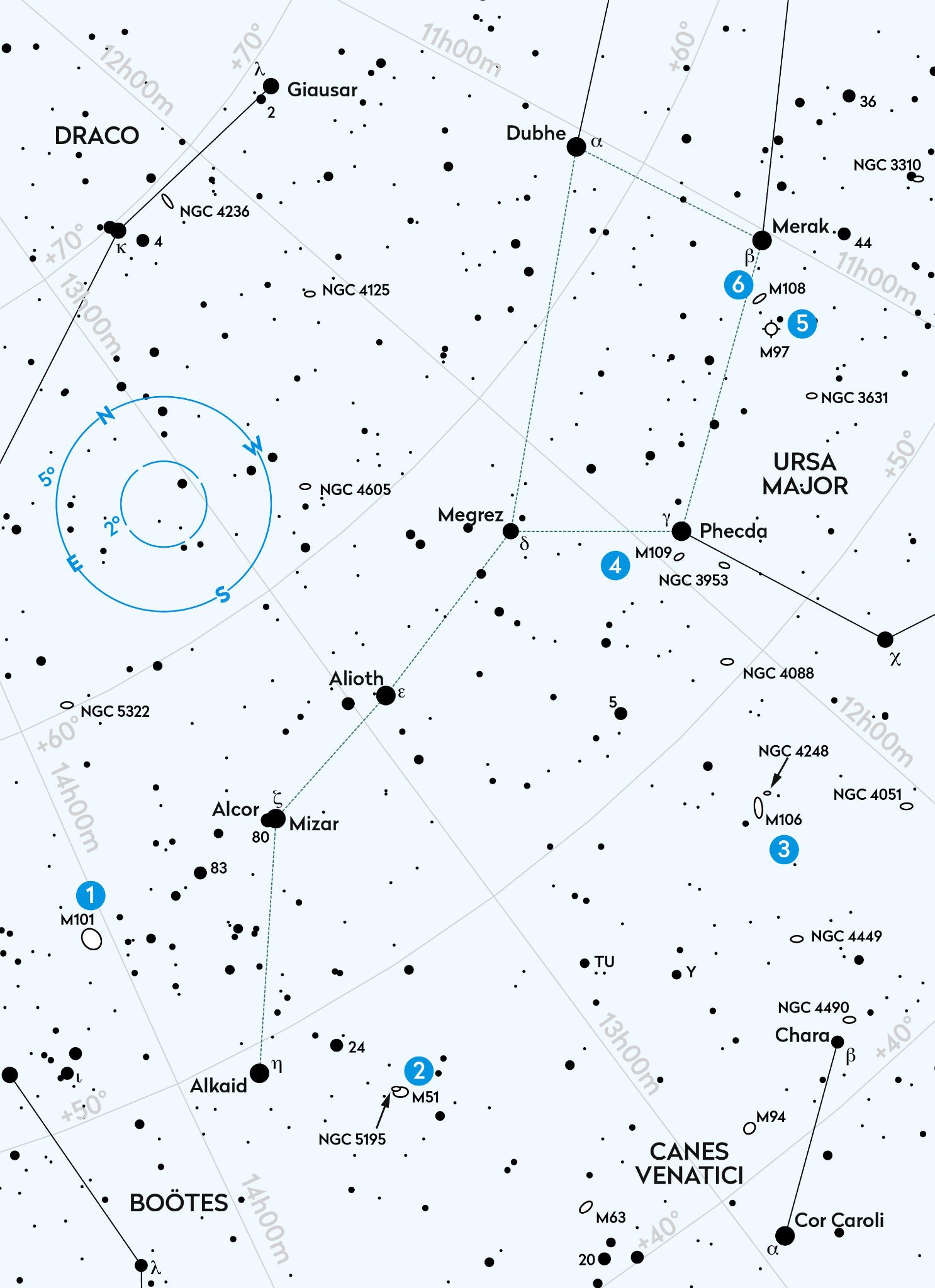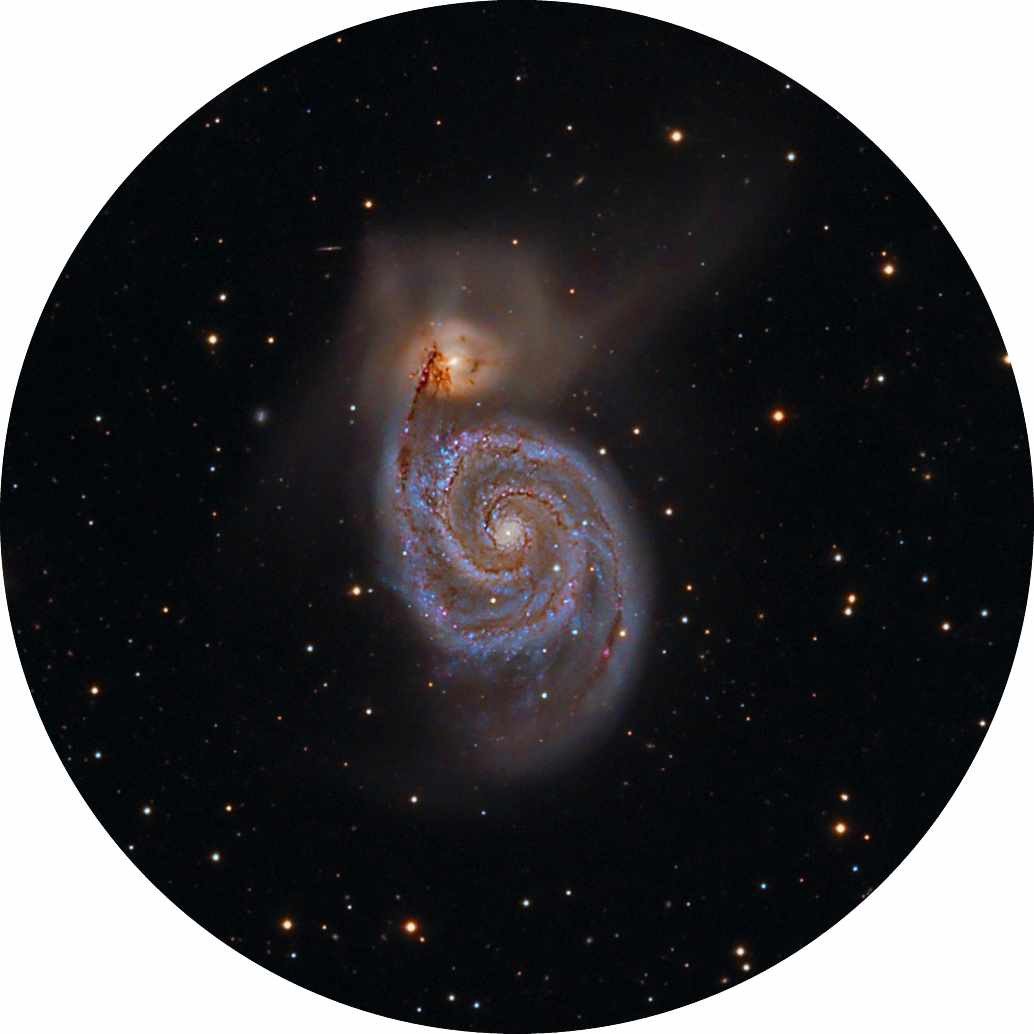Everybody knows the Plough, but can you find all six Messier objects in the surrounding field?

1 M101
Recommended equipment: Small/medium or large telescope
We start with M101, a mag. +7.9 face-on spiral galaxy also known as the Pinwheel. It’s easy to find, marking the northeast point of an equilateral triangle with Mizar (Zeta (ζ) Ursae Majoris) and Alkaid (Eta (η) Ursae Majoris). M101 appears large, 20 x 15 arcminutes through a 150mm scope, which gives it a low surface brightness, but it remains relatively easy to see. A small scope shows a mottled object with uneven brightness, definitely oval with a small, central nucleus. Larger instruments give more definition to the spiral arms, revealing distinct star knots.
2 M51
Recommended equipment: Small/medium or large telescope
M51, the Whirlpool Galaxy, is a mag. +8.4 spiral galaxy which, like M101, is presented face-on to us. However, M51 is smaller than M101 at 11 x 7 arcminutes and this gives it higher surface brightness. It lies within Canes Venatici, 3.6° southwest of Alkaid. Locate it by imagining it as the southwest point of an isosceles triangle with Alkaid and mag. +4.7 24 Canum Venaticorum. Smaller instruments show a mottled halo surrounding a brighter core. The galaxy has an interacting companion of apparently similar surface brightness but smaller: mag. +9.6, 5 x 4 arcminute NGC 5195. A 250mm or larger scope shows the tightly wound spiral arms of M51 well.
3 M106
Recommended equipment: Small/medium or large telescope
Next is galaxy M106, 12° west of M51 and roughly mid-way between Phecda (Gamma (γ) Ursae Majoris) and Chara (Beta (β) Canum Venaticorum). It’s a bright and large spiral galaxy, shining at mag. +8.4 with an apparent size of 19 x 8 arcminutes. Like M51, M106 lies in Canes Venatici. A 150mm scope shows it well, a mottled, granular object with a bright core region surrounding a bright nucleus. Larger instruments help pick out the tight spiral arms within the core. They appear somewhat lop-sided, the arm to the northeast appearing brighter. The smaller galaxy, NGC 4248, is located 13 arcminutes to the northwest. Although listed as mag. +12.6, with an apparent size of 3 x 1.2 arcminutes, its surface brightness isn’t dissimilar to that of M106.

4 M109
Recommended equipment: Small/medium or large telescope
M109 returns us to Ursa Major. This mag. +9.8 barred spiral is really easy to locate. Simply extend the line from Merak (Beta (β) Ursae Majoris) through Phecda, extending it for 39 arcminutes; using a low-power eyepiece, Phecda and M109 will probably appear in the same field of view. With a total apparent size of 7.6 x 4.9 arcminutes, M109’s surface brightness can be a struggle for smaller scopes which show it as a hazy patch. Its halo appears indistinct and faint, the core small but nicely concentrated. The galaxy’s central bar and tightly wound arms can be seen with larger instruments with powers of around 150–250x revealing the best views.
5 M97
Recommended equipment: Small/medium or large telescope
M97 is a planetary nebula with a reputation for being one of the harder objects in the Messier catalogue to see, mainly because of its low surface brightness. It’s listed at mag. +9.9 and has apparent dimensions of 3.4 x 3.3 arcminutes. Find it by heading one-quarter the distance from Merak towards Phercad, looking 0.8° south-southwest (perpendicular to the Merak– Phercad line) of this point. A 150mm scope shows a featureless circular glow. A 250mm instrument and averted vision may show two darker patches within the glow. A 300mm scope shows the 50-arcsecond patches better, but they are still far from easy. They have been likened to two eyes looking back at you, hence its informal name, the Owl Nebula. SEEN IT
6 M108
Recommended equipment: Small/medium or large telescope
You may have passed over our final target, the edge-on spiral galaxy M10, on your way to M97. To locate mag. +10.0 M108, head 1.5° from Merak along the Merak–Phecda line, then 0.3° south-southwest (perpendicular to the line). This can be a tricky object in small instruments, a 150mm scope revealing an elongated glow of 8 x 1.5 arcminutes. At 100x power it shows a clumpy, broken appearance, but seems to lack a core. Larger apertures brighten the galaxy, but fail to reveal anything more than the elongated, unevenly-lit halo hinted at by a smaller scope.
MORE ONLINE
Print out this chart and take an automated Go-To tour
www.skyatnightmagazine.com/bonus-content/KZRG5FS